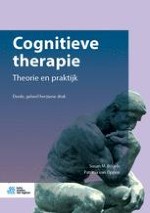
2019 | OriginalPaper | Hoofdstuk
1. Cognitieve verwerking en psychopathologie: theorie en onderzoek
Auteurs : dr. Elske Salemink, prof. dr. Merel Kindt, prof. dr. Filip Raes
Gepubliceerd in: Cognitieve therapie
Uitgeverij: Bohn Stafleu van Loghum

2019 | OriginalPaper | Hoofdstuk
Auteurs : dr. Elske Salemink, prof. dr. Merel Kindt, prof. dr. Filip Raes
Gepubliceerd in: Cognitieve therapie
Uitgeverij: Bohn Stafleu van Loghum
Print ISBN: 978-90-368-2020-2
Elektronisch ISBN: 978-90-368-2021-9
Copyright: 2019